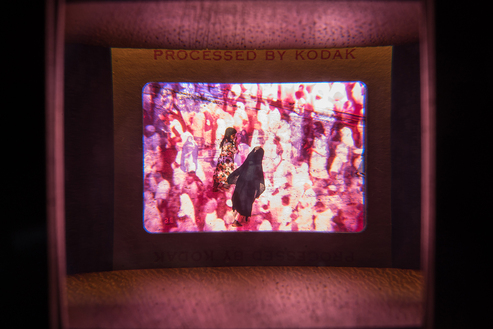-
From Current Issue
-
- Editor’s Letter Fire in the Heart
- Reviews I Gusti Ayu Kadek Murniasih
- Reviews 11th Seoul Mediacity Biennale: “One Escape at a Time”
- Dispatch Networked China
- One on One Monira Al Qadiri on Yukio Mishima
- Essays The rise of independent art spaces in pandemic-era Shanghai
- Features Tuan Andrew Nguyen
- Table of Contents
- Web Exclusives
- Archive
- Subscribe

R
E
V N
E
X
T
Installation view of AHMED MATER’s “Mitochondria: Powerhouses” at Galleria Continua, San Gimignano, 2017–18. Courtesy the artist and Galleria Continua.
In his multidisciplinary practice, Ahmed Mater explores the socioeconomic changes that are reshaping Saudi Arabia, offering a harsh look at the realities that are beyond the narratives of oil wealth and religious fundamentalism.
Mater was born in 1979 in Tabuk, a city in the northwest of Saudi Arabia, near the border with Jordan. At the age of 19, he entered medical school, and while shooting X-rays images at the government hospital in Abha, near the southern tip of the country, he developed an interest in photography. Five years later, he quit medicine to become an artist, but the experience of medical practice still infuses his work with references to scientific knowledge.
“Mitochondria: Powerhouses,” Mater’s exhibition at Galleria Continua in San Gimignano, drew its title from the name of an organelle—a cellular structure—the primary function of which is to power cellular activities in living beings with large quantities of energy. Drawing from this idea, and using multiple mediums, the show investigated two powerful forces that fuel the global economy: faith and the exploitation of natural resources.
Mater’s photo documentary project Desert of Pharan, Unofficial Histories behind the Mass Expansion of Mecca (2011– ) probes the idea of a faith economy by recording the redevelopment of Mecca. In an eye-catching aerial night view, the Ka’aba, Islam’s most sacred site, appears minuscule in the midst of skyscrapers and massive construction yards, which release a spectral fluorescent glow. A spectacular shot features a man clinging to a gold-colored crescent moon, suspended by a crane, during its installation on top of the Makkah Royal Clock Tower. The tower is part of the Abraj Al Bait, one of the world’s largest and tallest hotel complexes. Looming over the Ka’aba, the edifice appears in most pictures as a constant marker of the transformation of Mecca into a hyper-commercialized megalopolis, with the target of catering to 30 million pilgrims a year by 2025.
Images of the desert were also recurring throughout the show, as the subject of the artist’s current research on “economic cities” and the profit-driven conversion of thousands of square kilometers of sand dunes into new metropolises in the Arabian Peninsula. “Cities built purely for economic speculation, are soulless, ghost cities, setting an example of economy that may have great social and environmental repercussions,” the artist told me. “Moving to Riyadh, I recently started investigating life sustainability in the desert: nomadic populations survived in the desert, constantly moving after available resources; on the contrary, cities don’t move. Maybe we should start looking for sustainable solutions in the environment itself.”
Linking into this idea was Mitochondria: Powerhouses (2017), the show’s spectacular centerpiece. In the gallery’s central hall, pieces of fulgurite—tubes of vitrified sand that are sometimes formed when lightning strikes land—emerged from white jute bags filled with sand, with others planted in piles of sand on a raised floor, appearing like trees that thrive in bare landscapes. Fulgurite resembles dry and contorted roots or branches, and one had the impression of walking into a petrified forest. On a wall above the installation, a Tesla coil intermittently unleashed flashes of lightning, filling the gallery with deafening crackles—perhaps a metaphor of the desert as an energy-producing “powerhouse.”
By contrast, Ashab Al Lal / Fault Mirage (2016), an installation where visitors must peer into wooden boxes to view illuminated glass slides, was meditative. The work comprised of seven cases, each hosting two superimposed images. Pictures of desolate urban outskirts, and of people journeying on trucks and camels, blended into each other, resulting in blurred, mirage-like visions. Touching on themes of migration and collective memory, this enticing piece called upon fading memories, offering an intimacy in the physical experience of leaning in to fill one’s field of vision with these overlaid scenes.
“Mitochondria: Powerhouses” was an inspiring exhibition that raised thought-provoking questions from multiple viewpoints on topical issues, relating at once to the present conditions of the Arabian Peninsula and its relationship with the global economy. Mater’s socially informed art practice communicates positive energy, as it evidently stems from the belief that art can help us navigate the rapid changes in our surroundings, make sense of them, and even foster change.
Ahmed Mater’s “Mitochondria: Powerhouses” is on view at Galleria Continua, San Gimignano, until January 7, 2018.
To read more of ArtAsiaPacific’s articles, visit our Digital Library.









